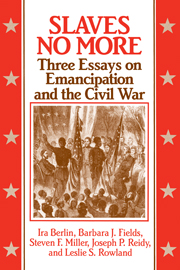2 - THE WARTIME GENESIS OF FREE LABOR, 1861–1865
Published online by Cambridge University Press: 05 June 2012
Summary
As slavery deteriorated during the American Civil War, fundamental questions arose about the social order that would take its place. Amid the tumult and danger of war, former slaves – usually designated “contrabands” or “freedmen” – struggled to secure their liberty, reconstitute their families, and create institutions befitting a free people. But no problem loomed larger than finding a means of support. Having relinquished the guarantee of subsistence that accompanied slavery, freedpeople faced numerous obstacles to gaining a livelihood. Many had fled their homes with little more than the clothes on their backs. Others had been abandoned by their owners. Nearly all began life in freedom without tools or land, with no certain source of food, clothing, or shelter, and with no means to provide for the old, the young, the sick, or the disabled. For generations the slaves' labor had enriched their owners. Now, in freedom, would they or others benefit from their toil?
Military operations in the slave states compelled Northern officials to confront the same questions. Fugitive slaves poured into federal lines, searching for protection and freedom. Other slaves came under Union control as Northern forces occupied parts of the Confederacy. From the first, military considerations encouraged officers in the field and officials in Washington to mobilize former slaves on behalf of the Union war effort. Provision also had to be made for those who could not be usefully employed by the army or navy.
- Type
- Chapter
- Information
- Slaves No MoreThree Essays on Emancipation and the Civil War, pp. 77 - 186Publisher: Cambridge University PressPrint publication year: 1992



